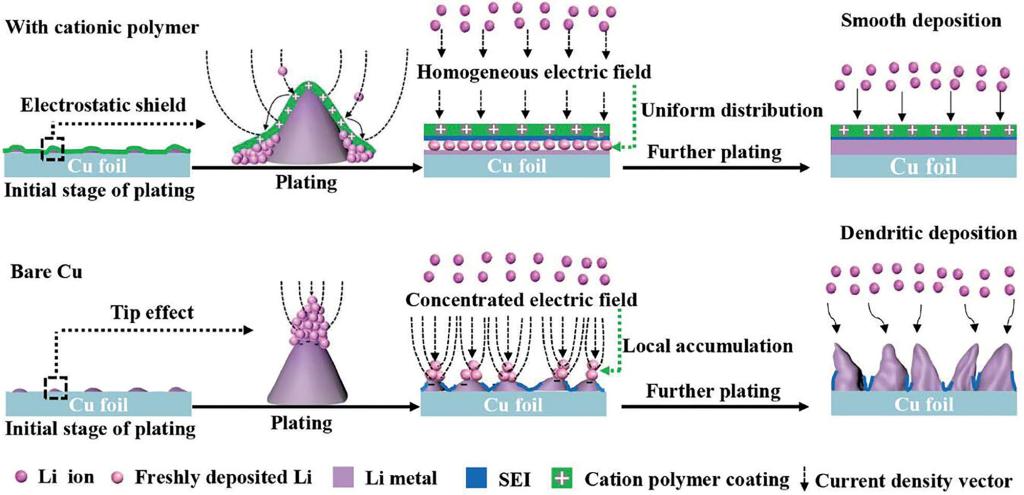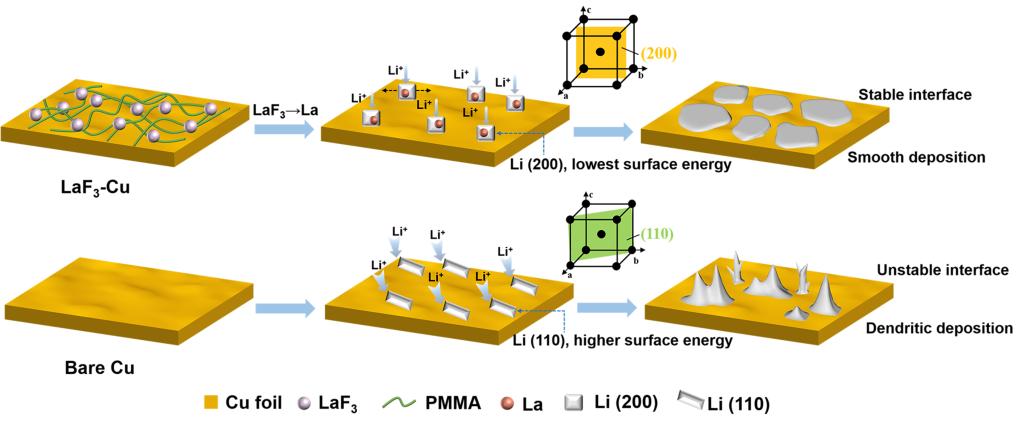The effective development and large-scale application of new energy technologies will bring great changes to the global energy landscape. The documents of 《The National Medium and Long Term Science and Technology Development Plan (2021-2035)》and 《The 14th Five-Year Plan for Science and Technology Innovation in the Field of Energy》 point out that energy storage technology, as the "last mile" of the energy revolution, is the key to solving the bottlenecks that limit the efficient use of clean energy. The energy density of lithium-ion batteries with the traditional graphite anode is close to the theoretical limit (~250 Wh kg-1), which cannot further satisfy the demand for energy density of rechargeable batteries in emerging fields such as aerospace, electric vehicles, and drones. The theoretical energy density of new energy storage batteries using lithium metal as anode (>400 Wh kg-1) is much higher than that of existing lithium-ion batteries. Therefore, lithium metal anode shows great promise in achieving high-energy-density rechargeable batteries. However, the practical application of lithium metal batteries is seriously impeded by the uncontrollable lithium dendrite growth and unstable lithium-electrolyte interface.
To address the above challenges, Professor Jiangxuan Song's group at Xi'an Jiaotong University has developed a self-adapting electrostatic interface for lithium metal anode. This electrostatic layer utilizes aromatic ring substituents to effectively homogenize electric field distribution, reduce the reduction potential, and realize electrochemical stability. Moreover, it also can adaptively homogenize the current density on the electrode surface, and thus achieving dendrite-free lithium deposition under high deposition capacity (4 mAh cm-2). The lithium metal pouch cell constructed based on this electrostatic interface exhibits excellent cycling stability and high energy density (>400 Wh kg-1) under harsh conditions (high areal capacity of 5.7 mAh cm-2, high current density of 2.7 mA cm-2, and lean electrolyte of 2.5 g Ah-1). The research results were published in Advanced Energy Materials, with Peiyu Zhao as the first author.

Mechanism of schematic diagram for the adaptive electrostatic interface
To further improve the stability of lithium metal batteries, Song group reported an in-situ lanthanum-doped lithium metal anode for high-specific-energy lithium metal batteries based on a lithium deposition crystal plane regulation strategy. The authors find that the preferred orientation is changed from the conventional (110) to the (200) crystal plane, which promotes the two-dimensional growth upon lithium deposition, and achieves a smooth and dense dendritic-free lithium deposition morphology even at an ultra-high area capacity of 10 mAh cm-2. Meanwhile, the La doping further decreases the reactivity of lithium metal towards electrolytes, thereby establishing a stable lithium-electrolyte interface. Notably, the pouch cell using this La-doped lithium metal anode delivers a high energy density of 425.73 Wh kg-1 and an outstanding cycling performance of 0.0989% decay per cycle under realistic conditions. The research results were published in Advanced Materials, with Yanhua Zhang and Peiyu Zhao as co-first authors.

Mechanism of schematic diagram for lanthanum-doped lithium metal
The above research results are all based on the State Key Laboratory for Mechanical Behavior of Materials of Shaanxi International Research Center for Soft Matter of Xi'an Jiaotong University as the first unit, Prof. Jiangxuan Song of XJTU as the sole corresponding author, and the collaborators of the paper include Prof. Junkai Deng and Prof. Chonggao Bao of XJTU and Yong Li of Shanghai Institute of Space Power-Sources. The characterization and testing work involved in this study was supported by the instrument analysis center of XJTU and the state key laboratory for mechanical behavior of materials of XJTU. The above research work was supported by the National Natural Science Foundation of China, the Natural Science Basic Research Program of Shaanxi, the Key Research and Development Project of Shaanxi, and the Natural Science Foundation of Shanghai.
Link to the paper:
https://doi.org/10.1002/adma.202211032
https://doi.org/10.1002/aenm.202200568
Group website
http://jxsong.xjtu.edu.cn/


